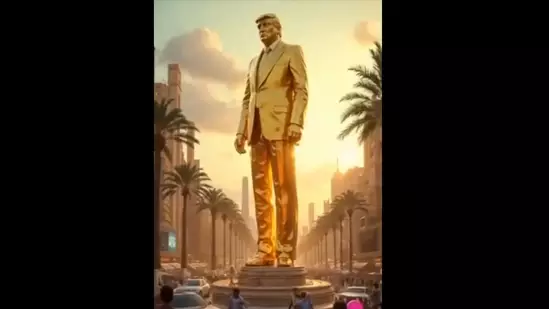In a bold and contentious move, former President Donald Trump recently took to his Truth Social platform to share an AI-generated video that illustrates his ambitious proposal for the redevelopment of Gaza. Released without any accompanying commentary, the slickly edited clip attempts to project a futuristic reinvention of the war-torn territory, showcasing a vibrant landscape filled with pristine beaches, towering skyscrapers, and ornate statues reminiscent of Trump himself. This imaginative portrayal served not only as a vision for Gaza but also as a flashpoint for criticism and concern from various stakeholders involved in the ongoing Israeli-Palestinian conflict.
The video intriguingly begins with stark visuals that capture Gaza in its current state, transitioning into an idyllic future tagged “Gaza 2025… What’s Next?” Here, the stark contrast of destruction and potential prosperity becomes the cornerstone of Trump’s narrative. Viewers see surreal images of AI-generated figures—one being Elon Musk, sharing a relaxed drink with Trump on a serene beach alongside a highly stylized representation of Israeli Prime Minister Benjamin Netanyahu. The accompanying jingle reinforces this aspirational vision, singing praises of a new life— “no more tunnels, no more fear”— suggesting a radical departure from the issues that have plagued the region for decades.
However, the tantalizing depiction meets harsh realism as critics voice their dissent. Wassel Abu Yousuf, a member of the Palestine Liberation Organization’s executive committee, lambasted the video as “a clowning gimmick,” dismissing the prospects it portrayed as disconnected from reality. The underlying sentiment echoes a broader frustration among Palestinians, who feel that their history and claims to land are being trivialized in favor of an artificial narrative that caters to a Western audience more interested in spectacle than substance.
Trump’s remarks during a White House press conference, stating that the U.S. would “take over” the Gaza Strip, raised eyebrows and prompted a wave of questions regarding the feasibility and ethics of such plans. He spoke about dismantling explosives and cleaning up debris, with the audacious claim that this would yield an economic boom—transforming Gaza into a land brimming with opportunity, jobs, and livable spaces. Yet, one must ponder: can such sweeping visions ever materialize without the consent and agency of the local populace, the very people whose lives would be affected by these transformative plans?
The conversation around Trump’s intentions is further complicated by the uproar it has incited across the Arab world. Leaders from nations including Egypt, Jordan, and Qatar convened in a show of solidarity to explore strategies aimed at protecting the rights of Palestinians and preventing additional displacement. This regional dialogue reflects a growing concern that any unilateral attempt to impose a solution on Gaza—especially one conceived in the realm of public relations rather than genuine diplomatic engagement—could exacerbate existing tensions.
Trump’s approach raises fundamental ethical questions about the intersection of politics, media, and the human rights of marginalized populations. By packaging geopolitical issues in a format that resembles entertainment, the true grievances of the Palestinian people risk being overshadowed by flashy visuals and catchy lyrics. The attempt to rebrand Gaza as a tourist haven may appeal to a specific audience, but it does little to address the ongoing humanitarian crisis or the generational trauma experienced by those who reside there.
Furthermore, the resort to AI-generated depictions in shaping public perceptions underscores a broader societal trend where reality is increasingly filtered through a digital lens. This raises concerns about authenticity and the consequences of creating narratives that may not reflect the lived experiences of those involved. It poses a question not just to policymakers, but to all of us: how do we ensure that the voices of individuals on the ground are not silenced in the pursuit of grand visions that glamorize their circumstances?
While Trump’s AI-generated portrayal of Gaza may certainly spark engagement and discussion, it is imperative that any proposed plans respect the historical and cultural significance of the land and its people. The road toward peace and recovery must be paved through dialogue and understanding rather than through fanciful projections devoid of the consent of the very individuals they affect. When envisioning a future, the people of Gaza should not merely be subjects of a political spectacle but active participants in shaping their own destiny.

